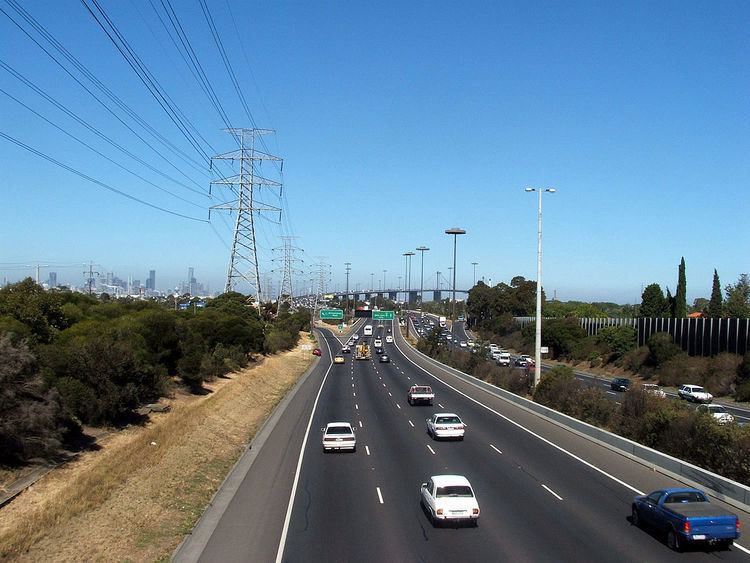Type Freeway Length 14 km | Opened 1971 | |
 | ||
Formerroute number East end CityLinkSouthbank, Melbourne Via Altona North, Spotswood, Port Melbourne | ||
West gate bridge west gate freeway in melbourne australia m1 eastbound
The West Gate Freeway is a major freeway in Melbourne, the busiest urban freeway and the busiest road in Australia, carrying upwards of 200,000 vehicles per day. It links Geelong (via the Princes Freeway) and the Western suburbs to the Melbourne CBD and beyond. It is also a link between Melbourne and the west and linking industrial and residential areas west of the Yarra River with the city and port areas. The iconic West Gate Bridge is a part of the freeway.
Contents
- West gate bridge west gate freeway in melbourne australia m1 eastbound
- Map of W Gate Fwy Victoria Australia
- History
- Timeline of construction
- 2008 upgrade
- Road Conditions
- References
Map of W Gate Fwy, Victoria, Australia
It is a fully managed freeway and one of the best examples of this in the world, with a complete 'Freeway Management System' that is dynamically linked and adaptive to the entire M1 corridor. This includes the 2008 re-design of a substantial section. Overall, the freeway has between 4-6 lanes in each direction, with a maximum of 12 lanes at one point in its width.
History
The original Lower Yarra Freeway was officially designated in the 1969 Melbourne Transportation Plan as the F9 Freeway corridor. Construction began on the first section in the late 1960s and was open to traffic by 1971, stretching from the intersection of the Princes Highway and Little Boundary Road in Altona North (later enlarged and named the West Gate Interchange) eastwards to Melbourne/Williamstown Roads just west of the mouth of the Yarra, initially designated with an F-82 shield. At the time, the only way to cross the Yarra west of the CBD was via a ferry crossing, which naturally saw far heavier demands once the Lower Yarra Freeway was officially opened.
The West Gate Bridge across the Yarra had started construction not too long before the opening of the freeway and, although delayed, when finally completed in 1978 allowed the freeway to extend over the river and directly into the CBD's south-western corner (via Rogers and Lorimer Streets). The freeway's name was changed to the West Gate Freeway to commemorate its opening, but the freeway also attracted tolls from anyone using the bridge (between Melbourne/Williamstown Road and Rogers Street) between 16 November 1978 and 29 November 1985. The toll plaza was located on the city side of the bridge where the service stations are now located. National Route 1 - previously designated along Geelong Road (Princes Highway West) and through the CBD via Smithfield and Flemington Roads and King Street - was altered to use the freeway instead and rejoin Kings Way via Rogers, Lorimer and Clarendon Streets.
Timeline of construction
Due to the extra traffic the West Gate Freeway was attracting—and due to the safety concerns of having excess traffic filter through connector streets in South Melbourne—the freeway was finally extended to Kings Way above the Grant Street intersection using elevated carriageways in 1987. Expansion of the original two lane freeway on the western side of the bridge to three lanes each way was carried out in 1993, and expansion to four lanes followed in 2000. With the subsequent completion of the Western Ring Road joining the West Gate Interchange to the freeway's west and CityLink to the freeway's east, it also funnels traffic from northern and western suburbs around Melbourne, acting as a bypass freeway.
The entire freeway has been given an M1 designation. It gains the Tourist 2 shield at the Melbourne/Williamstown Road interchange in Spotswood, and loses it at the Montague Street interchange in Port Melbourne.
2008 upgrade
Traffic volumes on the West Gate Freeway have grown steadily since opening, carrying up to 180,000 vehicles every day. Congestion frequently occurs at the Montague Street and Bolte Bridge interchanges due to conflicting traffic movements on and off the freeway. On 1 May 2008 the Minister for Roads and Ports Tim Pallas announced design details for the West Gate Freeway improvements, to assist in maintaining rapidly growing volume capacity and to reduce congestion
They are:
These works help reduce merging and weaving movements at key points on the freeway, leading to a smoother traffic flow and improved driver safety. As part of the works the Montague Street on-ramp city bound had been closed for approximately 18 months to enable the new one to be built.
Early works on the West Gate Freeway, including geo-technical investigations and service proving, commenced in late 2007. In early 2008 construction works started on the freeway widening, specifically in the South Melbourne area. New traffic lanes and ramps have be completed and opened in different stages with the total project scheduled for completion in late 2010.
The Freeway Upgrade was awarded the 2011 Australian Construction Achievement Award.
Road Conditions
The West Gate Freeway officially begins at the West Gate Interchange in Altona North, with four lanes running in each direction. The freeway flows from the Western Ring Road and the Princes Freeway with access to the Princes Highway (Geelong Road) also provided with city bound exit and Geelong bound entry ramps.
Soon after the bridge crossing, the freeway becomes elevated for its remaining length, with access ramps to Melbourne's central business district. Continuing to drive eastward on the freeway after the Power Street exit results in entering the electronically tolled CityLink, and travelling through the Burnley Tunnel.
Standard travel time on the West Gate Freeway in both directions, is 12 minutes. (5 minutes from the Western Ring Road to Williamstown Road and 7 minutes from Williamstown Road to Kings Way).
The usual peak period travel time, is between 16–24 minutes. However, in times of extreme congestion, including being residual due an incident, the travel time can go well beyond half an hour.
